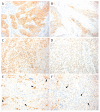Epithelial-to-Mesenchymal Transition and Neoangiogenesis in Laryngeal Squamous Cell Carcinoma
- PMID: 34283055
- PMCID: PMC8267619
- DOI: 10.3390/cancers13133339
Epithelial-to-Mesenchymal Transition and Neoangiogenesis in Laryngeal Squamous Cell Carcinoma
Abstract
The mechanism of epithelial-mesenchymal transition (EMT) is fundamental for carcinogenesis, tumor progression, cancer cell invasion, metastasis, recurrence, and therapy resistance, comprising important events, such as cellular junction degradation, downregulation of epithelial phenotype markers, overexpression of mesenchymal markers, and increase in cellular motility. The same factors that drive epithelial cells toward a mesenchymal phenotype may also drive endothelial cells toward a proangiogenic phenotype. The aim of this exploratory study was to investigate a potential interplay between EMT and angiogenesis (quantified through CD105 expression) in laryngeal carcinoma (LSCC). CD105-assessed microvessel density (MVD) and EMT markers (E-cadherin, N-cadherin, Snail, Slug, Zeb1, and Zeb2) were assessed on 37 consecutive LSCC cases. The univariate Cox regression model identified pN+ status (p = 0.0343) and Slug expression (p = 0.0268) as predictive of disease-free survival (DFS). A trend toward significance emerged for CD105-assessed MVD (p = 0.0869) and N-cadherin expression (p = 0.0911). In the multivariate Cox model, pN-status, Slug, and N-cadherin expressions retained their significant values in predicting DFS (p = 0.0346, p = 0.0430, and p = 0.0214, respectively). Our data support the hypothesis of a mutual concurrence of EMT and angiogenesis in driving LSCC cells toward an aggressive phenotype. To better characterize the predictive performance of prognostic models based on EMT and angiogenesis, further large-scale prospective studies are required.
Keywords: CD105; N-cadherin; Slug; angiogenesis; epithelial–mesenchymal transition; laryngeal squamous cell carcinoma; prognosis.
Conflict of interest statement
The authors declare no conflict of interest.
Figures



References
-
- de Morais E.F., Rolim L.S.A., de Melo F.A.D.R., de Farias Morais H.G., de Souza L.B., de Almeida Freitas R. Biological Role of Epithelial-Mesenchymal-Transition-Inducing Transcription Factors in Head and Neck Squamous Cell Carcinoma: A Systematic Review. Arch. Oral Biol. 2020;119:104904. doi: 10.1016/j.archoralbio.2020.104904. - DOI - PubMed
-
- Wan Y., Liu H., Zhang M., Huang Z., Zhou H., Zhu Y., Tao Y., Xie N., Liu X., Hou J., et al. Prognostic Value of Epithelial-Mesenchymal Transition-Inducing Transcription Factors in Head and Neck Squamous Cell Carcinoma: A Meta-Analysis. Head Neck. 2020;42:1067–1076. doi: 10.1002/hed.26104. - DOI - PubMed
Grants and funding
LinkOut - more resources
Full Text Sources
Research Materials

